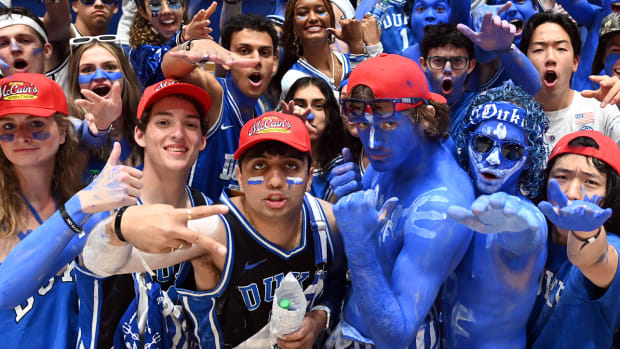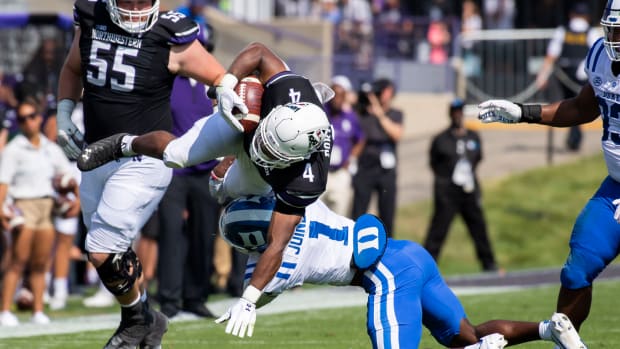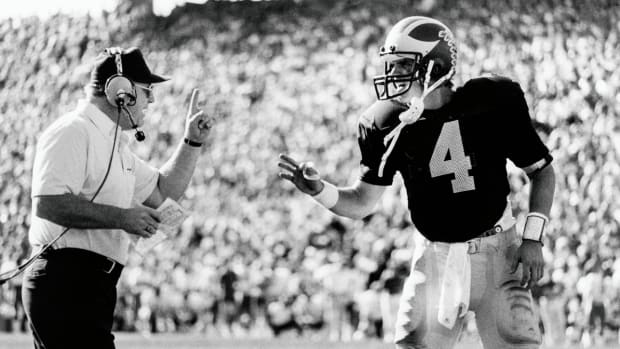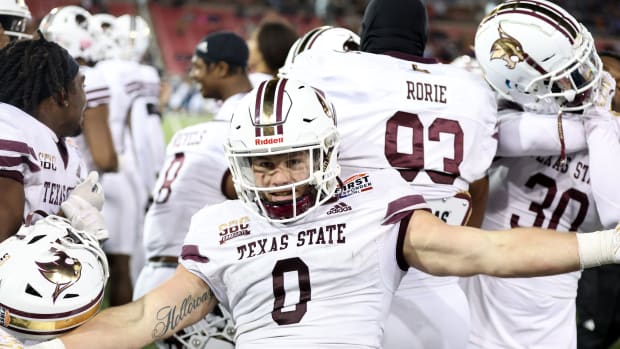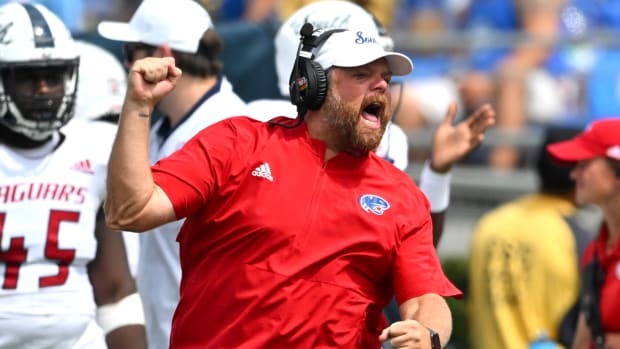Key play breakdown: Duke's six turnovers (part 1 of 2)
Duke turned the ball over six times in the wild 33-30 loss to Pittsburgh on Saturday.
The ACC Network put together a montage of the six game-changing plays.
The Blue Devils had three turnovers in the space of four offensive snaps in the first quarter, leading to Pitt’s first 10 points of the game.
Duke overcame its shaky start and made a late rally to take the lead briefly near the end of the game. After Pitt regained the lead, the Blue Devils had one final turnover to any hope of a last-second drive to victory.
We’ll look at what happened with all six turnovers. In this first part of a two-part series, we’ll break down the three that happened in quick succession in the first quarter.
Turnover No. 1: Quentin Harris fumble, 5:32, first quarter
The set up: Duke was leading 3-0 and facing a third and nine from its own 39. Harris rushed for the first down, but he was hit as he crossed the sticks, giving up the ball on Duke’s 49. It was the first of seven times that Pitt would start a drive in Duke territory.
The formation: Duke lined up with an empty backfield—two receivers to each side with Noah Gray tight to the left side of the line looking like he was going to run a route. In a familiar third-down sight on Saturday, Pitt showed blitz, putting seven defenders on the line.
The snap: Sure enough, Duke sends all five receivers out on routes. Pitt sends its three down linemen as well as linebacker Phil Cambell, with the other three defenders dropping into coverage—no blitz or trickery at all.
Before any receiver reaches the first down marker, Harris senses trouble. The right side of the pocket is in trouble. Campbell is pushing right tackle Jacob Monk backward, and end Habakkuk Baldonado is beating right guard Rak Chambers to the outside. Chambers will try to recover and eventually be knocked to the ground, right about where Harris is currently standing.
Harris tucks and runs. There’s plenty of open field just past the pocket. Three receivers ran deep and two turned toward the sideline after running short routes, pulling their defenders away from Harris’ room to run.
He’s hit from two sides just as he reaches the first down, however, and the ball comes out.
What went wrong: Monk and Chambers were beaten by their guys, which disrupted the play. Harris could have thrown to Scott Bracey, who had juked his defender to the ground (bottom of photo, just past the 40), although he would have had a tough time getting the first.
The decision to run was probably the correct one. Harris had one man to beat—linebacker Cam Bright, alone in the center of the field (No. 38, just ouside the D at midfield in the above photo). He’s the guy who applies the second hit, knocking the ball loose.
Turnover No. 2: Quentin Harris pick six, 4:49, first quarter.
The set up: Duke’s defense stopped Pitt on three and out following the fumble, and Pitt punted to the Duke 18. On the first play of the drive, Harris’ throws a pass toward Aaron Young. It’s tipped by cornerback Dane Jackson into the hands of safety Paris Ford, who runs it back 26 yards for a touchdown, giving Pitt the lead.
The formation: Duke is in empty backfield again. This has been one of Duke’s most successful sets this season, gaining an average of 14.5 yards on pass plays and 4.3 on runs (either quarterback scrambles or jet sweeps). Duke had gained 34 first downs and two touchdowns in 51 snaps heading into the Pitt game.
This time, Duke has four receivers on the right side with one lined up a step farther back than Harris, hinting at a possible lateral or receiver screen. With that side overloaded, he’s hoping to throw the other way and get Young in single coverage.
The snap: It looks promising from the start. Every Pitt defender except Jackson, who is covering Young at the top, is on the other side of the hash mark. Ford breaks in that direction as Harris throws, but without the tip, he wouldn’t have gotten there in time.
Pitt stunts on the left side of the line, but no one gets to Harris fast enough to disrupt the play. On the other side, end Patrick Jones splits Monk and Chambers and may hurry Harris a little bit.
What went wrong: Jackson grabbed Young briefly, slowing him up and allowing Jackson to stay with him. It could have gotten a flag but was quick and not blatant. Young begins protesting, looking for a flag while still running the route.
As the ball is tipped past him, he’s looking away from the play, arguing for a penalty.
He won’t react to the interception going on in front of him until Ford is 10 yards downfield from him, with the ball.
The pass was thrown behind Young, and that was with him being slowed by Jackson’s grabby hands. Monk, Chambers, Harris and Young all share a portion of the blame for this one.
Turnover No. 3: Harris interception, 4:07, first quarter.
The set-up: Duke gets the kickoff following the Pitt score and starts at its own 23. Mataeo Durant runs for two on first down. On second and eight, Harris throws in the direction of Jalon Calhoun and Ford intercepts. Pitt would get the ball at Duke’s 34 and get a field goal.
The formation: Stop us if you’ve heard this before. Duke sets up with an empty backfield. It’s the mirror image of the last play, with four receivers now flooding the left side, including one lined up deeper than Harris. Calhoun is lined up in the left slot.
Pitt again doesn’t blitz, but it has some trickery in the pass rush. Both defensive tackles stunt around the outside, with Amir Watts, who lines up on the right-hand side of the interior, looping around the left side of Duke’s line, while Jaylen Twyman, who is on the left side, loops all the way around to the right.

Both defensive tackles begin to loop around the long way while the offensive tackles engage the ends
This obviously takes longer than a straight rush, but neither of them are blocked, which helps them get there faster. Harris also takes a few steps back, loading up to throw deep. Likely Mataeo Durant, who lined up on wide left and is running the deepest route, is the primary target. Both tackles reach Harris just as he finishes his drop back, and he needs to switch receivers and hurry the throw.

On left, both defenders arrive at Harris. On right, Calhoun (middle, by yellow line) runs left to right (downward in pic). Durant (top right corner) runs deeper version of similar route.
It’s way behind Calhoun and Ford, who was just floating in the middle, is able to read it and make a leaping pick.

Ford (between yellow line and 35) makes the interception, several yards behind Calhoun (on hash mark at 37)
What went wrong: The line has a breakdown on the double stunt. Chambers, the right guard, is desperately trying to chase down Twyman, since Monk took the defensive end on that side, while left tackle Casey Holman also attempts to block the end first, before realizing too late what’s going on and scrambling unsuccessfully to recover.
On all three plays, Duke is in a formation that is one of its most successful, but problems—some created by Pitt’s defense and some self-inflicted—caused things to go awry on all three.
We’ll look at the other three turnovers in part two of the Key Play Breakdown, tomorrow.













